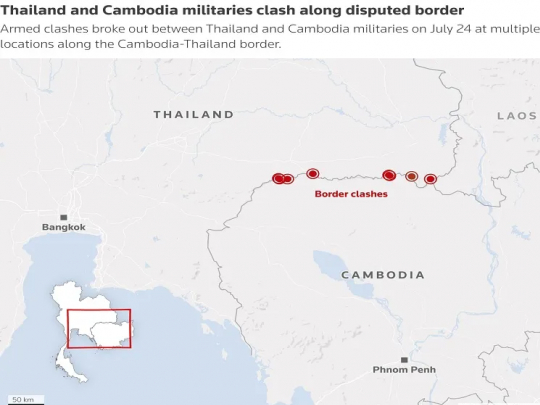Thailand’s Domestic Dynamics Are Likely Responsible For The Latest Clashes With Cambodia

They’re not due to some divide-and-rule plot by the US or anyone else like some might speculate.
Intense clashes broke out along the colonial-era French-drawn Cambodian-Thai border on Thursday in the latest phase of this long-running conflict. Both sides blame the other for starting it but there’s reason to believe that Thailand was the one that initiated hostilities. Before explaining why, it’s important to preemptively discredit the speculation from some multipolar-friendly observers who might soon claim that the US is behind these clashes, just like they blame it for every conflict in the Global South.
Cambodia is China’s top partner in ASEAN, with ties being so close that rumors have swirled for years that China is plotting in secret to set up a naval base there, claims that both sides predictably denied. What China is doing, however, is building a canal in Cambodia to alleviate its import and export dependence on the Mekong River whose mouth is controlled by on-and-off rival Vietnam. The strategic implications of this megaproject were analyzed here earlier in the spring.
As for Thailand, despite being a “Major Non-NATO Ally”, it’s also an official member of BRICS+ after formalizing its ties with the group at the beginning of this year. Like Cambodia, Thailand’s top trade partner is China, and there’s been occasional talk of it building a canal across the Kra Isthmus. The regional high-speed railway that China is constructing to Singapore will also transit through Thailand. These facts debunk speculation that Thailand might once again be acting as the US’ regional proxy.
The latest conflict is therefore the organic result of Cambodia and Thailand’s long-running conflict, which is over control of culturally significant historic temples along their disputed border, not some divide-and-rule scheme by the US or any other third party. That said, the aforementioned cause isn’t responsible for the latest outbreak of violence, which is arguably due to the influential Thai military’s damaged prestige stemming from a recent scandal over then-simmering tensions from May onward.
Prime Minister Paetongtarn Shinawatra was suspended less than a month ago after a leaked recording from a call with former Cambodian President Hun Sen about this dispute. He’s still very influential and used to be friends with her father, former Prime Minister Thaksin Shinawatra. Some of her comments were interpreted as insulting the armed forces, which are still extremely influential in Thai society and highly revered, not to mention responsible for a dozen coups, including one against Thaksin in 2006.
It's therefore not far-fetched to suspect that the proud Thai military, which dwarfs Cambodia’s by all metrics, initiated what it expected to be a brief but successful war in order to restore its damaged prestige among society. After all, given the aforesaid gross mismatch between their armed forces, it’s dubious that Cambodia would spark a war with much stronger Thailand while it’s much more believable that the Thai military would spark a brief one that it expected to win with much weaker Cambodia.
Both are the proud successors of rich and related civilizations, thus explaining the emotive context of this conflict, which is over control of culturally significant historic temples along their disputed border and whose latest phase was arguably initiated by the Thai military as explained. It remains unclear what the outcome will be, but the latest outbreak of violence wasn’t the result of any third party’s plot, it was the naturally occurring outcome of Thailand’s domestic dynamics after the Prime Minister’s recent scandal.
- Source : Admin










